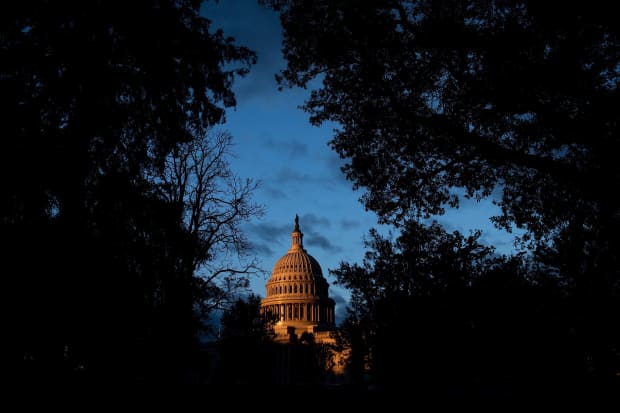This post was originally published on this site

The US Capitol in Washington.(Photo by Brendan Smialowski / AFP) (Photo by BRENDAN SMIALOWSKI/AFP via Getty Images)
Septembers in Washington in even-numbered years usually follow a well-worn script. One party raises the prospect of a government shutdown, the other dismisses it, followed by haggling and a deal by Sep. 30.
This year, as it has been in so many other ways, could be different.
Lawmakers will juggle passing another coronavirus aid package with the need to extend government funding into the new fiscal year starting Oct. 1, among other priorities. And some view the chances for failing to do one or both of those as increasing.
The outcome may turn on whether a bill to avoid a government shutdown by passing a temporary spending bill called a continuing resolution and any fiscal stimulus bill, are tied together. A spokesman for House Speaker Nancy Pelosi said Thusrday she favors separate tracks for each issue.
“She has said she believes they should be separate as the COVID package is urgent and needs to come ASAP,” Pelosi spokesman Drew Hammill said in an email.
At the White House, a spokeswoman said President Donald Trump’s administration was not worried about a shutdown.
“I have not talked to him about that, but we do believe we can get funding to avoid a shutdown,” White House Press Secretary Kayleigh McEnany told reporters.
Talks over another coronavirus financial aid package foundered in July, and attempts to restart them in August failed. Pelosi said Democrats were willing to come down to $2.2 trillion, while Mark Meadows,the White House chief of staff, said the White House offer had come up to $1.1 trillion plan.
But combining the talks, with the consequence of a shutdown if they do not succeed, may be the best way to get a deal, observers say.
“There’s a decent chance they can work something out in the end, but I don’t see how it’s possible,” said Jim Manley, a former spokesman for Harry Reid, the Democratic Senate Majority Leader from 2007 to 2015.
“Combined, it would raise the likelihood that both get done,” said a Republican former congressional leadership aide, speaking on condition of anonymity. “I’m getting more and more pessimistic about substantial COVID response legislation.”
If the bills are separated though, the former aide said, a path could be cleared easily for a stopgap spending bill by itself that would keep the government open into the post-election lame duck period.
“There’s definitely a danger of shutdown,” the ex-aide said. If the president is trailing in the polls, he could insist on provisions in the continuing resolution that Democrats could not accept, forcing their hand.
“The president is the real wild card in this,” Manley said.
As if keeping the government’s lights on and finishing hard-fought negotiations that started in July weren’t enough, Congress faces a Sept. 30 deadline to do two other things: extending the legislative authority for federal transportation and flood insurance programs.
Absent a reauthorization, the flood insurance program’s ability to borrow money to cover losses would be reduced from $30 billion to $1 billion, according to the Congressional Research Service. The transportation bill had been seen as the legislative vehicle to do a big infrastructure bill, a prospect that now seems remote.
In addition to those extensions, which typically would be rolled into a stopgap spending bill, both the House and Senate face the prospect of votes on bills that, charitably speaking, are not expected to be signed into law soon but are meant to boost support for the parties ahead of the November elections.
In the House, in the week of Sept. 21, a vote is expected on a bill to largely decriminalize marijuana at the federal level. The Senate will have a procedural vote on a federal judge nomination upon its return Sept. 8 but could turn to other issues afterwards.
Before leaving for the summer recess in August, Senate Majority Leader Mitch McConnell advanced three House bills procedurally, including one on statehood for the District of Columbia, potentially easing their way for floor votes in September.
Manley said those would be “message bills designed to boost the base.”
Even so, they will eat into precious floor time. Between traditional Thursday departures and two religious holidays in the month, the Senate is likely to be in session only 11 days through Sept. 30. While House committees are to be working next week, the full House is also set to be in session for only 11 days before the end of the month.


